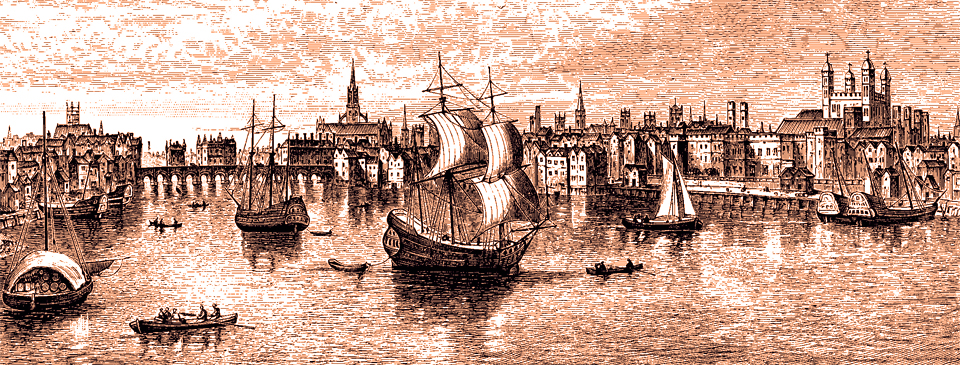The Port of London in the Tudor period

A view of the Thames c1550
Ships were arriving in London from as far as Barbary (the Atlantic coast of Morocco), Danzig (Gdansk), Venice and Russia. The annual tonnage of shipping entering the port rose 50 percent in the second half of the 16th century. At the beginning of Elizabeth’s reign in 1558 a new set of regulations were introduced, instigated by the Lord Treasurer, the Earl of Winchester. Following a commission on royal revenues, customs duties in the port were reorganised, adding 300 types of merchandise on which duty was payable.
In order to manage collecting duties new rules restricted all goods being imported by ship into London, other than beer, coal from Newcastle, and corn, to a limited number of wharves on the north bank of the river, mostly between London Bridge and the Tower. These became known as the ‘Legal Quays’. Cargoes from then on could only be loaded and unloaded under the watch of Customs officials at those locations. Those wharves at the ancient Queenhithe – in use since Saxon times – as well as Gravesend, Barking, Blackwall and many other places, ceased to be used for imports. The Legal Quays were to maintain their monopoly on the landing of imports into the Port of London for the following 250 years.
The wharves were thus concentrated in the City of London but in other respects the Port of London gradually spread eastwards. As we have seen, the Thames east of London became a major centre of shipbuilding. Many captains and crew members and their families lived in the hamlets close to the river at Wapping and Ratcliffe, some of whom were buried in their parish church of St. Dunstan at Stepney. Distinguished Elizabethan mariners included: William Borough (part of the crew of Sir John Willoughby’s first Arctic expedition in 1553 and second in command to Francis Drake in the expedition to Cadiz in 1587), Sir Henry Palmer (a leading English commander against the Spanish Armada), Christopher Newport (Admiral of Virginia), and William Coxe (master of the Golden Hind on Sir Humphrey Gilbert’s expedition to Newfoundland, who died in combat against the Spanish Armada), all of Limehouse; and John Vassall of Ratcliffe (one of the founders of Virginia).
During the Middle Ages London was a small port on an island at the periphery of Europe. From the end of the Tudor period that began to change and by the 18th century it had become the country’s leading financial centre, the capital of a growing empire and a major port at the centre of the world.
Sources include: Ian Friel ‘Maritime History of Britain And Ireland’; Gustav Milne ‘The Port of Medieval London’; Caroline M. Barron ‘London In The Later Middle Ages’; John Schofield ‘London 1100-1600’; Liza Picard ‘Elizabeth’s London’; John Pudney ‘London’s Docks’; Fiona Rule ‘London’s Docklands’; Arthur Bryant ‘Liquid History’; Sir Hubert Llewellyn Smith ‘The History of East London’; Miranda Kaufmann ‘Black Tudors’, Robert Brenner ‘Merchants and Revolution’.
< Back to The Port of London


